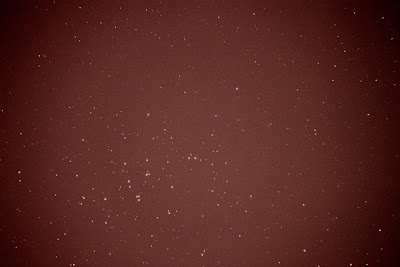
Desaturated image taken with the Meade. Some of the adjustments show a darkening of the corners of this photograph. The regular JPEG image was much brighter and I toyed with some basic settings to come up with this image. There are better photos out there. This is just a quick attempt to see what the Meade can do with a favorite viewing target.
This is a 30 second photo a 3200 ISO. The extra speed or gain of the 3200 ISO doesn't really provide any additional nebulous or glowing gas detail at this exposure setting. The added gain and brightness of the image didn't provide any advantage over lower ISO settings. An 800 ISO is probably as high a gain necessary to capture faint stars with the same detail as above. Lower speeds might provide sharper details of the stars, with less noise or apparent "grain".
Image GAIN by ELECTRONIC GAIN.
Cameras like the Canon T1i don't "group" pixels like BINNING settings. Astrophotography cameras often group them using a "BINNING" techique. Grouping pixels together to create a virtual super pixel will give more gang or sensitivity, but less detail and resolution. Getting more bright exposures using gain is a different way of doing the same thing but will introduce more noise. (Do you want more noise or less resolution.) There's a theory perhaps, if I recall it correctly that BINNING can be done with some photos in a stack and higher resolution in other photos and then you can combine them. The BINNED photos might have lower resolution, but you're getting clouds and more undefined objects in those photos. There's also photographic formulas that some use to decide how much resolution is possible at the image sensor and this can result in BINNED photos in theory showing as much detail as un-binned ones.
Turning up the gain as the EOS and other consumer CCD cameras for the general market will not reduce resolution by introducing "grain", but rather introduce a grain like gain smudging perhaps. (At least that's my take on it.)
This could introduce more noise artifacts that appear to have a grain like appearance. The HIGHER ISO setting can have some apparent resolution loss with a grainer look, but technically this isn't from less resolution it's from more gain.
IN REGARDS TO M45
http://seds.org/messier/m/m045.html
Please take a look at the link above. Most photos of the Pleiades on the net often show a blue glow of dust that is not present in this photo. They may be using a bigger setup or longer exposures. The Pleiades is one of my favorite things to look at. I like looking at this with a wide field telescope and low powered eyepieces. This almost gives me a wide field view like a pair of binoculars would.
Some say it's better to look at it with binoculars. I don't know if that's really true, there's probably some advantages to using binoculars. I haven't looked up much through large binoculars so I couldn't really say they are better or worse. According to some observers, binocular viewing tends to be easier on the eyes providing less eye strain.
I was looking at a large pair of Vixen binoculars at the swap meet. They wanted about $1000 for them. Probably a pretty good deal. This pair of binoculars was basically two small refractors. I actually thought they would cost more when I looked at them, but the retail price was pretty low.
What is the ideal setup for visual viewing at the observatory? Maybe it would be having some arrive and bring their scopes along. This has been mentioned before by some in the FAAC group. Maybe we could bring a scope or two and have them outside. This would allow groups to look through more than one telescope at more than one object. They could compare the views between smaller setups and the big C-14. It could create a sense of anticipation in the group as they progressed to the C-14 and also give them an idea of the different types of telescopes available.
Would you like to compare this to a wider screen longer exposed photo to see what a difference longer exposures and better astrophotography can make. Check out this image. It's almost scaled exactly the same horizontally with a comet in the photo which is a stitch of two photos from a narrower field of view.
ReplyDeletehttp://en.wikipedia.org/wiki/File:Pleiades-comet-Machholz.jpeg